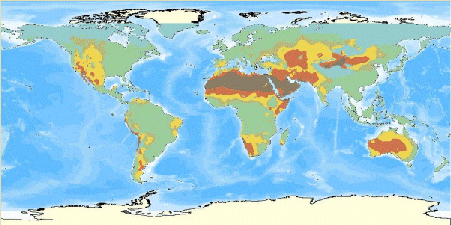Drylands cover approximately 47% of the Earth’s land surface and are home to over 2 billion people. Encompassing ecosystems as diverse as arid and semi-arid lands, grasslands, savannahs, and Mediterranean landscapes, drylands are found throughout the world and provide very important contributions to the global economy.
 |  |
 | The largest areas of drylands are found in Australia, China, Russia, the United States, and Kazakhstan. |
 | There are six countries with at least 99% of their area classified as drylands: Botswana, Burkina Faso, Iraq, Kazakhstan, the Republic of Moldova, and Turkmenistan. |
 | Approximately 44% of the world’s cultivated systems are found in drylands. |
 | Urban areas account for only 2% of the world’s drylands but house approximately 45% of the global drylands population. |
When calling to mind images of drylands we are often inclined to envision vast expanses of sand, devoid of life. In reality drylands support a vast array of unique and well-adapted wildlife.
 | The Serengeti grasslands in Sub-Saharan Africa support an annual migration of approximately 1.3 million blue wildebeest, 200,000 plains zebra and 400,000 Thomson’s Gazelle. |
 | The Mediterranean Basin contains 11,700 plant species that do not grow naturally anywhere else in the world. |
 | The Succulent Karoo region of South Africa and Namibia, with more than 1,700 leaf-succulents, contains the richest succulent flora on Earth. |
 | Well-known animals such as horses, sheep, goats, and cows all originated in drylands. |
Drylands biodiversity is of critical importance to people. In addition to providing ecosystem services such as the provision of food and fodder and the regulation of nutrient and water cycles, drylands biodiversity decreases the vulnerability of human populations to famine and disease resulting from the frequent hazards that often characterize dryland areas. Even beyond the borders of dry areas, drylands biodiversity is highly valued and widely used.
 | Some of the world’s most important food crops, including wheat, barley, and olives, originated in dry and sub-humid lands. |
 | Dry and sub-humid lands provide genetic sources for one third of the plant-derived drugs available in the US. |
 | African cattle, which are more diverse than cattle from any other region in the world, are very resistant to drought and tropical disease and can thrive even on low quality fodder. |
Drylands are, however, facing increasing threats. As the impacts of pollution, overuse, climate change and invasive species menace dry and sub-humid areas people and biodiversity suffer.
 | Between 6 and 12 million square kilometers of dry and sub-humid lands are affected by desertification. |
 | Desertification threatens the livelihoods of more than 1 billion people worldwide. |
 | 8 of the world's 10 poorest countries are located in dry or sub-humid lands. |
 | In developing countries, infant mortality in dry and sub-humid lands is twice as high as in all other areas. |
 | The IUCN Red List of Threatened Species lists 2,311 threatened species in dry and sub-humid lands including: the California Condor, the Black Rhinoceros, and the African Wild Dog. |
 | 15 known dry and sub humid land species that are either extinct or extinct in the wild, including, the Wild Horse, the Arabian Gazelle and the Wyoming Toad. |
 | Between 1830 and 1994 the extent of tall-grass prairie in North America has decreased by 97%. |
The Convention on Biological Diversity programme of work on the biological diversity of dry and sub-humid lands seeks to achieve the 2010 biodiversity targets within drylands. The implementation of the programme of work has already yielded some success.
 | The Cape Mountain Zebra faced extinction from hunting, reaching a low of seven females in 1950. Although it is still endangered the current population is estimated at 1,200. |
 | Zambia, Zimbabwe, and Mozambique have developed a transboundary elephant management plan. Since its inception in 2001, the population of elephants has increased by 8% in Zimbabwe and Mozambique and an astounding 400% in Zambia. |
 | Captive breeding programmes have increased the population of the critically endangered California Condor from 25, in the 1970s, to more than 100 today. |
Despite this progress much remains to be done. It was with this in mind and in celebration of the International Year of Deserts and Desertification that the Conference of the Parties to the Convention on Biological Diversity selected ‘Protect biodiversity in drylands’ as the theme for the International Day for Biological Diversity to be held on May 22nd, 2006.
To Top